The Catholic University of America
| The Catholic University of America | |
|---|---|
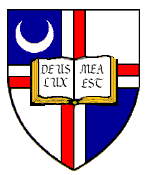 |
|
| Motto | Deus Lux Mea Est |
| Motto in English | God Is My Light |
| Established | 1887 |
| Type | Private |
| Religious affiliation | Roman Catholic |
| Endowment | $154 million[1] |
| Chancellor | Most Reverend Donald Wuerl |
| President | John H. Garvey |
| Academic staff | 694[2] |
| Students | 6,705[2] |
| Undergraduates | 3,469[2] |
| Postgraduates | 3,236[2] |
| Location | |
| Campus | Urban |
| Athletics | 21 NCAA Division III varsity teams, Landmark Conference, except football (Old Dominion Athletic Conference) |
| Colors | Academic Gold and White Athletic Red and Black |
| Nickname | CUA |
| Mascot | Cardinal |
| Website | http://www.cua.edu |
The Catholic University of America (CUA), located in Northeast Washington, D.C., is the national university of the Roman Catholic Church and the only higher education institution founded by U.S. Roman Catholic bishops. Established in 1887 as a graduate and research center following approval by Pope Leo XIII on Easter Sunday,[3] the university began offering undergraduate education in 1904.
CUA's programs emphasize the liberal arts, professional education, and personal development. In areas besides academics, the school stays closely connected with the Catholic Church and Catholic organizations. The American Cardinals Dinner is put on by the residential U.S. Cardinals each year to raise scholarship funds for CUA. The university also has a long history of working with the Knights of Columbus, and the university's law school and the university's basilica have dedications to the involvement and support of the Knights of Columbus.
The university's campus lies within the Brookland neighborhood, known as "Little Rome", that contains 60 Catholic institutions, such as the academic institutions of Dominican House of Studies and Trinity Washington University.
The university has been visited twice by reigning Popes. Pope John Paul II visited on October 7, 1979.[4] On April 16, 2008, the Pope Benedict XVI came to campus and addressed representatives of Catholic education gathered in the Edward J. Pryzbyla University Center.[5] The Pope used the opportunity to revisit the topic of Catholic education and academic freedom, with which he had been involved before becoming pope and which had precipitated the firing of a tenured CUA professor.[6]
Contents |
History
The proposal to create a national Catholic university in America reflected the rising size and influence of the nation’s Catholic population and also an ambitious vision of the Church’s role in American life during the 19th century.
In 1882 Bishop John Lancaster Spalding went to Rome to obtain Pope Leo XIII's support for the University and persuaded family friend Mary Gwendoline Caldwell to pledge $300,000 to establish it. On March 7, 1889, the Pope issued the encyclical Magni Nobis,[7] granting the university its charter and establishing its mission as the instruction of Catholicism and human nature together at the graduate level. By developing new leaders and new knowledge, it was believed that the University would strengthen and enrich Catholicism in the United States.[8]
Many of the founders of the CUA held a vision that included both a sense of the Church’s special role in United States and also a conviction that scientific and humanistic research, informed by the Faith, would only strengthen the Church. They sought to develop an institution like a national university that would promote the Faith in a context of religious freedom, spiritual pluralism, and intellectual rigor.
When the University first opened for classes in the fall of 1888, the curriculum consisted of lectures in mental and moral philosophy, English literature, the Sacred Scriptures, and the various branches of theology. At the end of the second term, lectures on canon law were added and the first students were graduated in 1889. In 1904, an undergraduate program was added and it quickly established a reputation for excellence.[9] A survey conducted in 1912 by the federal Bureau of Education placed CUA among the best institutions in the nation at preparing undergraduates for graduate studies.
The presence of CUA attracted other Catholic institutions to the area—including colleges, religious orders, and national service organizations. Between 1900 and 1940 more than 50 international Catholic institutions rented or owned property in neighboring Brookland which gave the neighborhood the nickname 'Little Rome.' The period after World War II saw the rise of Catholic visibility in America, and particular prominence for CUA. During the first post-war years, Catholic University experienced an expansion in enrollment thanks to the G.I. Bill.
Today there are over 6,000 students on campus from all 50 states and around the world.
Campus
The CUA campus is in the residential community of Brookland in Northeast Washington; its main entrance is 620 Michigan Ave., NE. The campus is bound by Michigan Avenue to the south, North Capitol Street to the west, Hawaii Avenue to the north, and John McCormick Road to the east. map It is three miles (5 km) north of the U.S. Capitol Building.
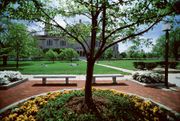
The tree-lined campus is 193 acres (0.78 km2). Romanesque and modern design dominate among the university’s 55 major buildings. Between McMahon and Gibbons halls and alongside the Basilica of the National Shrine of the Immaculate Conception runs The Mall, a large strip of grass that is often the site of kickball games and sunbathers. Conte Circle is in the middle of Centennial Village, a cluster of eight residential houses.
The Edward J. Pryzbyla University Center was opened in the spring of 2003, bringing student dining services, the campus bookstore, student organization offices, an 800-person ballroom, a convenience store, and more student services under one roof. The John K. Mullen Library completed a $6,000,000 renovation in 2004, significantly improving the lighting and aesthetics of the interior and allowing the classical architecture to better shine through.
The Columbus School of Law is on the main campus and is self-contained in its own building with moot courtrooms, a library, chapel, classrooms, and offices. On the Pryzbyla Center side of the building is the Law School Lawn, where the ultimate Frisbee team can often be found. Theological College, the United States's national seminary, is located across Michigan Avenue from the main campus and sits between the Dominican House of Studies, a seminary for the Order of Preachers, and offices for the Oblates of Mary Immaculate. Trinity Washington University is also near the university and is a quarter mile south along Michigan Avenue.
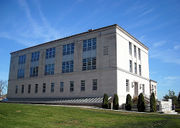
In April 2004, the University purchased 49 acres (200,000 m2) of land from the Armed Forces Retirement Home. The parcel is the largest plot of open space in the District and makes CUA the largest university in D.C. by land area. There are currently no plans for the parcel other than to secure the property for future growth.
In 2007, the University unveiled plans to expand the campus by adding three new dorms to the north side of campus.[10][11] The first of these dorms, the seven-story tall Opus Hall, houses 420 upper-class students, making it the largest dorm on campus. The three new dorms, when completed, are set to replace the two still functioning dorms on the south side of campus, Conaty and Spellman.
The Campus is served by the Brookland-CUA station on the Red Line of the Washington Metro. Union Station, Capitol Hill, and the Smithsonian museums are only a few minutes' ride away. Near campus is the Pope John Paul II Cultural Center, the Franciscan Monastery, and the offices of the United States Conference of Catholic Bishops.
Green Initiatives and Sustainability
The Catholic University of America is reaching for environmental sustainability by having active programs in the community, including participation in Earth Day and Casey Tree Planting. Campus Beautification Day also promoted green living. Sustainability has been identified as one of the "key goals" of CUA’s Office of Energy and Utilities Management.[12] CUA constructed its most recent building, Opus Hall, as LEED-compliant, and purchases 30% of its electricity from green sources.[12] The university is participating in the 2010 College Sustainability Report Card rating.[13][14]
In 2009, the CUA School of Architecture and Planning introduced a new Master of Science in Sustainable Design degree.[12]
Academics
As of July 2009[update], Catholic University has 11 schools and the Metropolitan College[15] in addition to 21 research centers and facilities. The 11 schools offer Doctor of Philosophy degrees (or appropriate professional degrees) in 66 programs and Master's Degrees in 103 programs.[2] Undergraduate degrees are awarded in 72 programs by six schools: architecture and planning, arts and sciences, engineering, music, nursing and philosophy.[2]
Undergraduates combine a liberal arts curriculum in arts and sciences with courses in a major field of study. Metropolitan College provides programs for adults who wish to earn baccalaureate degrees or participate in continuing education and certificate programs on a part-time basis. 88% of undergraduates and 61% of graduate students are Catholic.[16]
Catholic University is the only U.S. university with an ecclesiastical faculty of Canon law and is one of the few U.S. universities with ecclesiastical faculties of philosophy and sacred theology. Theological College, the university seminary, has prepared men for the priesthood in many dioceses of the United States. The School of Theology and Religious Studies is a member of the Washington Theological Consortium.[17]
Ninety-eight percent of full time faculty have doctoral or terminal degrees and 68% teach undergraduates.[2] Of the full time faculty, 59% are Catholic.
CUA was one of the fourteen founding members of the Association of American Universities. It withdrew its membership in 2002, citing a conflict with its mission; it is one of two schools to ever do so.[18]
Research centers and facilities
Over time, several national Catholic scholarly associations became based at the university, including the Catholic Biblical Association of America, publisher of the Catholic Biblical Quarterly, and (for many years) the American Catholic Philosophical Association.
Research institutes located here include:
- Center for Advanced Training in Cell and Molecular Biology
- Center for Advancement of Catholic Education
- Center for American Catholic Studies
- Center for Catalan Studies
- Center for Irish Studies
- Center for Medieval and Byzantine Studies
- Center for Pastoral Studies
- Center for the Study of Culture and Values
- Center for the Study of Early Christianity
- Center for the Study of Energy and Environmental Stewardship
- Center for Ward Method Studies
- Homecare and Telerehabilitation Technology Center
- Institute for Astrophysics and Computational Sciences
- Institute for Biomolecular Studies
- Institute for Christian Oriental Research
- Institute for Communications Law Studies
- Institute for Policy Research and Catholic Studies (formerly the Life Cycle Institute)
- Institute for Sacred Music
- Institute for Social Justice
- Institute of Musical Arts
- Latin American Center for Graduate Studies in Music
- Vitreous State Laboratory
Academic freedom
Although the University continues to be under censure by the American Association of University Professors (AAUP) for academic freedom violations and continues to ban certain speakers from campus, CUA has made a general statement of policy that the academic freedom of its faculty and students will be respected.[19] It considers academic freedom a "fundamental condition for research and dissemination of information."[19] The policy sets forth its respect for the right and responsibility of its faculty and students to (i) conduct research, (ii) publish their findings, and (iii) discuss ideas according to the principles, sources and methods of their academic disciplines.[19] The University further "sanctions" the investigation of "unexplored phenomena, advancement of knowledge, and critical examination of ideas, old and new" and "accepts the responsibility of protecting both teacher and student from being forced to deny truth that has been discovered or to assert claims that have not been established in the discipline."[19]
However, the University specifically provides that "theologians" in the University are "expected to give assent to the teachings of the magisterium in keeping with the various degrees of assent that are called for by authoritative teaching."[19] It should be noted that the Catholic University of America does not offer general studies in theology. Instead it offers doctorates in historical theology and systematic theology, the latter of which “undertakes the task of a comprehensive and synthetic understanding of the Christian faith as mediated through the Scriptures and the Catholic Tradition and as interpreted by the conciliar and papal magisterium [20] In addition it offers ecclesiastical degrees (i.e., licensees to teach Catholic Theology) in Liturgical Studies and Sacramental Theology, Moral Theology/Ethics, and Historical and Systematic Theology [21] In order to teach theology at The Catholic University of America, one must be licensed to teach Catholic Theology by the Vatican.
American Association of University Professors censure
In 1967, tenured professor Reverend Charles E. Curran was fired for his views on birth control, but was reinstated after a five-day faculty-led strike.[22] In 1986, the Vatican declared that Curran could no longer teach theology at Catholic University of America schools, because "clashes with church authorities finally culminated in a decision by the Sacred Congregation for the Doctrine of the Faith, headed by then-Cardinal (and now Pope) Josef Ratzinger, that Curran was neither suitable nor eligible to be a professor of Catholic theology."[23] The areas of dispute included publishing articles that debated theological and ethical views regarding divorce, "artificial contraception", "masturbation, pre-marital intercourse and homosexual acts."[24] As noted in the American Association of University Professors report, "Had it not been for the intervention of the Sacred Congregation for the Doctrine of the Faith, Professor Curran would undoubtedly still be active in the university's Department of Theology, a popular teacher, honored theologian, and respected colleague."[25] Curran's attorneys argued that CUA did not follow proper procedures or its own policy statements in handling the case. In essence, CUA claimed that the Vatican's actions against Curran trumped any campus-based policy or tenure rules.
In 1989, he filed suit against Catholic University, and the court determined that the University had the right to fire him for teaching views in contradiction to the school's religion.[26]
In 1990, the American Association of University Professors (AAUP) defended Curran and censured the Catholic University of America due to its failure to adhere to the AAUP's Principles on Academic Freedom and Tenure, and that it found that "unsatisfactory conditions of academic freedom and tenure have been found to prevail" at the Catholic University of America. As of July 2009[update], the Catholic University remains on the list of censured institutions.[27] The two conditions for having the censure removed are inviting Curran, whose license to teach Catholic Theology had been suspended by the Vatican, back to campus and changing the University's "Statement on Academic Freedom."[28] Current CUA President David M. O'Connell refuses to do either stating, "Every American university has a right to govern itself according to its own identity, mission, standards and procedures."[28]
However, the Middle States Association of Colleges and Schools continues to accredit CUA and renewed the accreditation in 2005.[29][30] In a controversy not involving CUA in the 1980s, the Southern Association of Colleges and Schools noted "the right of an institution to pursue its established educational purpose," supports the "governing board" decisions on upholding "the interests of the founders, the supporting religious group, the supporting governmental agency, or other supporting party." [31]
Speaker policy
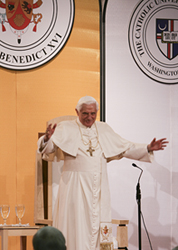
The University as a policy does not allow outside guests to speak on campus to any audience if they have previously expressed an opinion on abortion rights (as well as other issues) that conflicts with the Catholic Church's official position. Applying this policy in 2004, CUA was criticized for preventing Stanley Tucci from presenting in a seminar about Italian cinema (after he was already scheduled to do so), because he had lent past support for Planned Parenthood, a pro-choice organization.[32]
In a letter to the campus that next month, CUA President David O'Connell wrote:
I consider any pro-choice advocacy — whether deliberate or accidental, whether presented under the guise of academic freedom or right to free speech — as incompatible with that fidelity and not worthy of The Catholic University of America.[33]
The next year, in 2005, the school was criticized for initially rejecting an application for recognition of a student chapter of the NAACP; one of the reasons officials cited in its rejection was the national organization's pro-choice stance.[34] In 2006 the CUA administration barred a student-run on-campus performance of Eve Ensler's The Vagina Monologues. The Editorial Board of the student newspaper The Tower, in supporting the decision to ban the production, stated that "as much as we love variety, diversity and open-mindedness, this University is not the best place for that to flourish."[35]
The speaker policy gained national attention again in 2008 when the CUA College Republicans, the University's largest student organization, hosted former Homeland Security Secretary Tom Ridge. Ridge was campaigning on a moderate pro-choice platform despite being a Roman Catholic. In spite of this, school officials still approved Ridge to speak. Members of the Cardinal Newman Society heavily criticized the organization. The College Republicans responded with a statement criticizing the restrictiveness of the policy.[36]
Student life

There are over 100 registered student clubs and organizations at CUA for a wide variety of interests including athletics, academics, social, Greek life, service, political and religious.
Although the Catholic University states that it does not have any Greek life on campus, it in fact has two social Greek organizations and one service Greek organization. Catholic University Greek Life includes Alpha Delta Gamma the National Catholic Social Fraternity–Kappa chapter, Kappa Tau Gamma the local Christian Social-Service Sorority, and Alpha Phi Omega the National Service Fraternity–Zeta Mu chapter which is co-ed.
In the Starting in the 2008 academic year student government at CUA became the CUA Student Association. The Student Association included two original parts: the General Assembly, as an advocacy body, and the Student Fee Allocation Board which serves as the steward of the Student Activity and Club Sports Fee. This form of student representation at the university continues to exist.
The graduate student government is a separate entity and was not affected by the changes during the 2006-2007 academic year. Annual events include week-long Homecoming celebrations, the Mr. CUA competition, and a number of dances including the Beaux Arts Ball, the Mistletoe Ball, and the Athletes Ball. In addition to the radio station WCUA, other campus media outlets include The Quorum, the campus political magazine, CUA-TV, the campus television station, The Tower, the campus' independent weekly newspaper, and CRUX, a literary magazine.
While the university welcomes students of all faiths, 84% of undergraduates and 59% of graduate students self-identify as Catholic. The campus ministry has two groups of student ministers: the "resident ministers" who live in residence halls and focus primarily on upperclassmen and the "house members," who focus on freshmen.
The Friday Night Planning Committee works with the house members to plan activities for Friday nights that are alcohol free. Campus ministry also coordinates university liturgies, plans and runs retreats, provides faith formation including R.C.I.A., and operates the online Prayernet.
The music and drama programs stage productions each semester, performances ranging from Broadway productions to plays.
The DuFour Athletic Center has hosted The Alarm, The Fixx, Black 47, Gavin DeGraw, Brandi Carlile, The Hooters, They Might Be Giants, Howie Day, and The Ataris. Comedy acts include Ben Stein and Big Al Goodwin. The university's Program Board, which puts on many of the concerts on campus as well as the annual Mistletoe Ball, provides other activities for the entire CUA community. Previous events include ski trips, advanced screenings of movies, Noise In The Pryz, and the Movies on the Mall.
There is a Symphony orchestra, and choral groups. A Cappella performances are given by two groups: Take Note and RedLine.[37]
Athletics
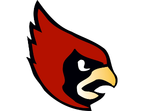
The Cardinals were originally known as the Red and Black, after the colors they wore, and came to be known as the Cardinals (often the Flying Cardinals, occasionally the Fighting Cardinals) in the mid-1920s. The first recorded football game was played against Mount Saint Mary's College on November 28, 1895 but records indicate earlier track and field events.
CUA sponsors 21 NCAA Division III sports teams. The school competes in football in the Old Dominion Athletic Conference, in men's baseball, softball, women's volleyball and field hockey, and in men's and women's cross country, soccer, basketball, swimming, lacrosse, tennis, and indoor and outdoor track and field, in the Landmark Conference.
CUA competed in Division I, where they won a national championship in boxing (1938), the baseball team advanced to the NCAA Division I Tournament in 1977, and the football team appeared in two major bowl games (the 1936 Orange Bowl, which they won and the 1940 Sun Bowl, which they tied), until the academic year of 1981-82, when they decided to move to Division III.
Since then, the men's basketball team won the 2001 NCAA Division III National Championship and was the only program in Division III to reach the Sweet Sixteen five consecutive seasons, from 1998-2002. They also reached the postseason in 1993 and 1996. The football team has made three consecutive trips to the Division III playoffs. The track & field team has produced three national champions, while the swimming program has two individual national titles as well. The volleyball team made its first NCAA tournament appearance in 2001 and followed it up in 2002, while the field hockey team advanced to the 2001 ECAC Southern Region championship game. The men's swim team has won four Capitol Athletic Conference titles and three National Catholic Division III championships, while women's swimming has won a Catholic Division III title and softball has an ECAC Southern Region title. In 2008, the women's lacrosse team went undefeated in the inaugural year of the Landmark Conference and winning the Conference post-season tournament. Ultimately, the team garnered a birth in the NCAA tournament for the first time in program history, making it to the regional finals where they lost to runner-up Salisbury University. It was the first time a spring sport at CUA ever went to the NCAA tournament. In the fall of 2008, the Football team went to the ECAC Southeast Bowl and defeated Johns Hopkins University 18-17 to give the Cards their first post season win since 1935.
Wally Pipp, A.B. 1914, played for the New York Yankees and lost his position as starting first baseman to Lou Gehrig at the beginning of Gehrig's streak of 2,130 consecutive games. Ripley's Believe It or Not! once featured Edward Lynch, LL.B. 1924, for making 98 tackles in a single football game.
Club Sports
Students field club teams in sports including cheerleading, ice hockey, rugby, and rowing.
- The ice hockey team competes in the Blue Ridge Hockey Conference and plays at the Fort Dupont Ice Arena.
- Both men's and women's rugby teams compete in the Collegiate Division II pools of the Potomac Rugby Union.
- The Catholic University of America Rowing Association rows on the Anacostia River out of the Bladensburg Waterfront Park in Maryland.
Notables
Notable alumni
There are many notable alumni of The Catholic University of America, particularly in the arts, in the Church and in public service. Graduates include numerous cardinals, bishops, priests and nuns. CUA's Current total of Alumni exceeds 83,000.
Members of the United States House of Representatives and Senate, ambassadors, governors, state legislators, mayors, and judges have also attended CUA. Additionally, many notable actors, playwrights, columnists, and social activists are alumni in addition to film, theatrical and television producers. Others include CEOs, scholars and university presidents.
Notable faculty
- Clyde Cowan, co-discoverer of the neutrino
- Msgr. Joseph Clifford Fenton, peritus to Cardinal Ottaviani at the second Vatican Council
- Oleg Kalugin, former KGB spy
- Theo Holm (1854–1932), botanist[38]
- Carl Amery, German writer[39]
- Douglas Kmiec Legal Counsel to President Reagan; United States Ambassador to Malta; faith advisor to President Obama; served as Dean & St.Thomas More Professor, Columbus School of Law
- John M. Slattery, Jr., Actor
- Archbishop Fulton Sheen taught philosophy 1926-1950[40]
University rectors and presidents
- Bishop John J. Keane (1887–1896)
- Bishop Thomas J. Conaty (1896–1903)
- Bishop Denis J. O'Connell (1903–1909)
- Bishop Thomas J. Shahan (1909–1927)
- Bishop James Hugh Ryan (1928–1935)
- Bishop Joseph M. Corrigan (1936–1942)
- Bishop Patrick J. McCormick (1943–1953)
- Bishop Bryan J. McEntegart (1953–1957)
- Bishop William J. McDonald (1957–1967, last Rector)
- Clarence C. Walton, Ph.D. (1969–1978, first President)
- Edmund D. Pellegrino, M.D. (1978–1982)
- Rev. William J. Byron, S.J. (1982–1992)
- Brother Patrick Ellis, F.S.C. (1992–1998)
- Very Rev. David M. O'Connell, C.M., J.C.D. (1998–2010)[41]
- John H. Garvey (2010-)[42]
Board of trustees
CUA was founded by the nation's bishops, and they continue to have a presence on the Board of Trustees to this day. Of the 51 trustees (including the University president), 24 are bishops (including eight cardinals). In addition, there are one religious sister and two priests.
References
- ↑ http://www.nacubo.org/Documents/research/2009_NCSE_Public_Tables_Endowment_Market_Values.pdf
- ↑ 2.0 2.1 2.2 2.3 2.4 2.5 2.6 "Fact Book". http://publicaffairs.cua.edu/factbook/facts.html. Retrieved 2009-04-09.
- ↑ The Very Rev. David M. O'Connell, C.M. (2003-04-10). "Remarks at the Dedication of the Edward J. Pryzbyla University Center". http://publicaffairs.cua.edu/news/03DOCPryzDedicationRemarks.htm. Retrieved 2008-10-09. Easter fell on April 10 in 1887.
- ↑ Videos of his two addresses on campus can be seen here.
- ↑ Papal visit information
- ↑ "Pope: Catholic colleges should be in line with church"
- ↑ Magni Nobis
- ↑ The founding, and Spalding's role, are covered in A Catholic University; The Zeal of a Few Prelates Rewarded, N.Y. Times, June 15, 1885, at 5. Spalding was quoted: "Let there be, then, an American Catholic University, where our young men, in the atmosphere of faith and purity, of high thinking and plain living, shall become more intimately conscious of the truth of their religion and of the genius of their country, where they shall learn the repose and dignity which belong to their ancient Catholic descent, and yet not lose the fire which glows in the blood of a new people...."
- ↑ The president of the first undergraduate class was Frank Kuntz, whose memoir of that period was published by the University press. Frank Kuntz, Undergraduate Days: 1904-1908 (CUA 1958). The University gives an annual award named for Kuntz.[1]
- ↑ 'Campus Gothic' Dorm Set for Spot Near Flather - News
- ↑ Construction Begins for Opus Hall - News
- ↑ 12.0 12.1 12.2 Master, Maggie (May 1, 2009). "CUA Makes Strides in Environmental Sustainability". Inside CUA. http://inside.cua.edu/081031/story1.cfm. Retrieved 2009-08-03.
- ↑ "The College Sustainability Report Card". http://www.greenreportcard.org//. Retrieved 2009-06-08.
- ↑ "Plant Trees". http://planttrees.cua.edu//. Retrieved 2009-06-08.
- ↑ http://www.cua.edu/academics/schools-colleges.cfm
- ↑ http://publicaffairs.cua.edu/factbook/facts.html Retrieved 2009-08-03.
- ↑ "Member Institutions". Washington Theological Consortium. http://www.washtheocon.org/members.html. Retrieved 2009-10-02.
- ↑ Paul Fain, As AAU Admits Georgia Tech to Its Exclusive Club, Other Universities Await the Call, The Chronicle of Higher Education, April 21, 2010, Accessed May 31, 2010.
- ↑ 19.0 19.1 19.2 19.3 19.4 Statement on Academic Freedom
- ↑ CUA School of Theology and Religious Studies
- ↑ CUA School of Theology and Religious Studies
- ↑ An Urge to Retire Time Magazine July 21, 1967
- ↑ Loyal Dissent Memoir of a Catholic Theologian
- ↑ http://www.aaup.org/NR/rdonlyres/9CA4679F-7BC7-4AD7-BA37-0C1B00AEBAA1/0/CatholicUUSA.pdf quoting Cardinal Ratzinger. Retrieved 2009-07-30.
- ↑ "Academic Freedom and Tenure". Academe. Sept-Oct 1989. http://www.aaup.org/NR/rdonlyres/9CA4679F-7BC7-4AD7-BA37-0C1B00AEBAA1/0/CatholicUUSA.pdf. Retrieved 2009-07-30.
- ↑ Curran Loses Suit Against Catholic U.; Theology Professor's Dismissal Upheld
- ↑ http://www.aaup.org/AAUP/about/censuredadmins/default.htm Retrieved 2009-07-30.
- ↑ 28.0 28.1 [2]
- ↑ http://www.msche.org/institutions_view.asp?idinstitution=86 Retrieved 2009-07-30.
- ↑ http://www.campuscorner.com/district-of-columbia-colleges/catholic-university-of-america.htm Retrieved 2009-07-30.
- ↑ Mazza, Michael J. (February 1995). "HEART ATTACK: CATHOLIC ACADEME MEETS "EX CORDE ECCLESIAE"". "Fidelity" Magazine. http://www.ewtn.com/library/ACADEMIC/CATHACAD.HTM. Retrieved 2009-07-30.
- ↑ Washington Post, September 17, 2004
- ↑ InsideCUA Online
- ↑ The Tower, April 22, 2005
- ↑ The Tower, February 3, 2006
- ↑ [3]
- ↑ [4]
- ↑ Tucker, A.O., Poston, M.E. & Iltis, H.H. (1989) History of the LCU Herbarium, 1895-1986. Taxon 38 (2): 196-203.
- ↑ Carl Amery - Obituaries The Independent, accessed: 6 August 2008
- ↑ [5]
- ↑ [6]
- ↑ [7]
External links
|
||||||||||||||
|
|||||
|
|||||||||||
|
|||||
|
|||||
|
|||||||||||